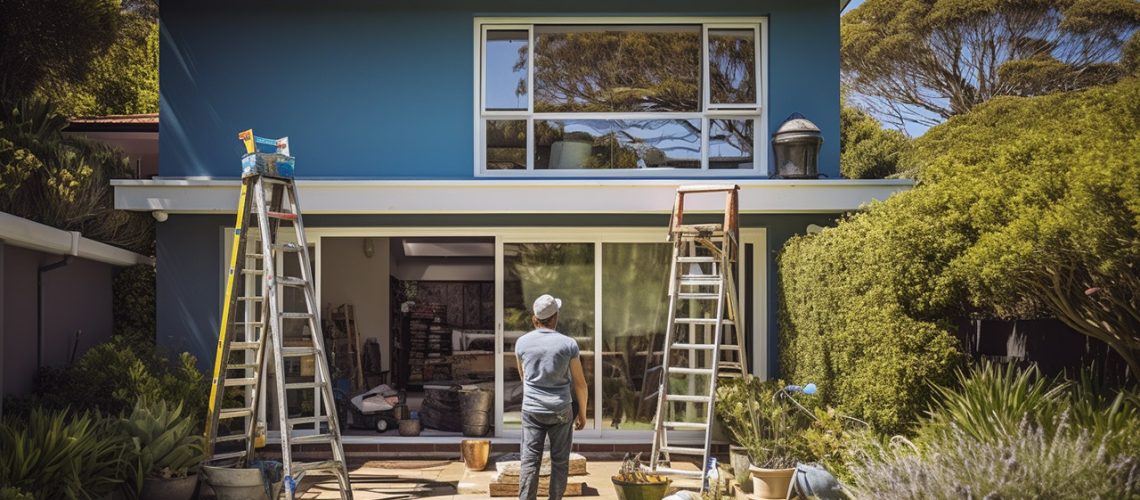Painting is more than just a decorative endeavour; it’s a protective measure for your home or building. However, achieving a flawless finish isn’t only about choosing the right colour or paint type; the temperature at which you paint plays a crucial role too. This guide delineates the ideal temperatures for painting, the effects of temperature on paint, and how to navigate painting in extreme temperatures.
Ideal Temperature for Painting
The temperature can significantly impact how well paint adheres to a surface and dries. While the perfect temperature can vary slightly based on the paint type and the specific project, a general range of 10°C to 32°C is often recommended for both indoor and outdoor painting.
Best Temperature for Interior Painting
When painting interiors in Sydney, sticking to a moderate temperature range, say between 10°C to 30°C, can often yield the best results. During moderately hot weather, windows and doors can be left open to facilitate ventilation, aiding the drying process. Humidity levels should ideally be within the range of 40% to 50%.
Best Temperature for Painting Outdoors
For outdoor painting projects in Sydney, it’s advisable to paint when the temperature ranges between 10°C to 32°C. This range ensures the paint adheres well and dries uniformly, resulting in a durable and aesthetically pleasing finish. For exterior painting, you should aim for a humidity level between 40% to 70%. Avoid painting when the humidity is above 80%.
Effects of Temperature on Paint
Temperature plays a crucial role in determining the quality of a paint job. It affects various factors, including paint viscosity, colour stability, adherence, and overall performance. It is important to understand the impact of temperature on these aspects to ensure a successful painting project.
Paint Viscosity
The viscosity of paint refers to its thickness or consistency. Higher temperatures can cause the paint to become thinner, resulting in a higher flow rate. Conversely, lower temperatures make the paint thicker, leading to a slower flow rate. It is essential to adjust the viscosity of the paint according to the temperature to achieve optimal application and coverage.
Colour Stability
Temperature fluctuations can have a detrimental effect on the colour stability of paint. Extreme temperatures, particularly high heat, can cause colours to fade or change over time. Therefore, it is important to store paint in a cool and controlled environment to maintain colour durability.
Adherence
The ability of paint to adhere properly to a surface is also influenced by temperature. Extremely cold temperatures can hinder paint from bonding effectively, leading to peeling or flaking. On the other hand, high temperatures can cause paint to dry too quickly, resulting in poor adhesion. It is crucial to choose the right temperature conditions for painting to ensure optimal adherence.
Performance
Temperature affects the overall performance of paint, including its durability and resistance to wear and tear. Extreme temperature conditions can weaken the paint, making it more susceptible to cracking, chipping, or fading. Proper consideration of temperature during the painting process can help enhance the longevity and performance of the painted surface.
The temperature during the painting process significantly impacts the overall quality of the job. Ignoring temperature considerations can lead to various issues such as improper paint flow, inadequate colour retention, poor adhesion, and decreased durability. By understanding and managing temperature effectively, painters can ensure a high-quality finish and long-lasting results.
Mitigating the impact of temperature on paint quality through proper techniques and materials
To mitigate the negative effects of temperature on paint quality, it is crucial to employ appropriate techniques and materials. This includes:
- Using temperature-resistant paints designed for specific temperature ranges
- Applying paint during the optimal temperature range to ensure proper flow and adhesion
- Storing paint in a cool and controlled environment to maintain colour stability
- Implementing proper surface preparation techniques to enhance paint adherence
- Using primers or sealers that are compatible with the temperature conditions
Painting in Extreme Temperatures
Painting in extreme temperatures can present various challenges that may affect the overall outcome of your project. In extremely hot temperatures, the paint can dry too quickly, making it difficult to achieve a smooth and even finish. On the other hand, painting in extremely cold temperatures can cause the paint to freeze, resulting in poor adhesion and potentially ruining your hard work.
Effects of extreme temperatures on paint application and quality
Extreme temperatures can have detrimental effects on the application and quality of paint. In hot temperatures, the paint may become too thin, leading to runs and drips. Additionally, the heat can cause the paint to bubble or blister, resulting in an uneven surface. In cold temperatures, the paint may become thick and difficult to spread, making it challenging to achieve a professional-looking finish.
Techniques and precautions for painting in extreme temperatures
When painting in extreme temperatures, it is crucial to take certain precautions and use specific techniques to ensure the best results. If painting in hot temperatures, try to work during the cooler parts of the day, such as early morning or late afternoon. This will help prevent the paint from drying too quickly. Maz Nazimmi, a professional painter at Dupaint, offers the following tip “When painting in hot temperatures, use two paint brushes and keep one in a small bucket of water to stop it from drying out, when needed, you can alternate the brushes.”
On the other hand, if painting in cold temperatures, consider using a specialized cold-weather paint or adding a paint conditioner to improve the paint’s flow and adhesion.
Best practices for handling adverse temperature conditions during the painting process
When facing adverse temperature conditions during the painting process, it is essential to follow certain best practices to achieve the desired outcome. Firstly, make sure to store your paint in a temperature-controlled environment before and during the painting process. This will help maintain the paint’s consistency and ensure optimal application. Secondly, keep an eye on the weather forecast and plan your painting schedule accordingly. Lastly, make sure to read and follow the manufacturer’s recommendations for temperature ranges specific to the paint you are using.
In summary, extreme temperatures pose challenges but are navigable with the right strategies:
- Hot Weather: Painting early in the morning or late in the afternoon can be the best time to paint your home interior. Also, it can be advisable to choose shaded areas if painting outdoors.
- Cold Weather: Use paints formulated for cold weather and ensure surfaces are prepped adequately.
- Humid Weather: Avoid painting on extremely humid days as it can affect drying and adhesion.
Frequently Asked Questions
What temperature is too cold for paint?
The minimum temperature for painting is usually around 10°C, although some paints are formulated for colder temperatures.
What happens if you paint below 10 degrees?
When painting in temperatures below 10 degrees, a range of adverse effects can manifest on the paint and its application. For instance, alkyd and oil-based paints tend to become thicker in colder conditions, posing challenges during application. On the other hand, water-based paints, often referred to as ‘latex’, run the risk of freezing in such temperatures.
What is the maximum temperature for painting?
The maximum temperature is around 32°C, but some paints can withstand higher temperatures.
What happens if I paint in the wrong temperature?
Painting at the wrong temperature can lead to a host of issues including poor adhesion, extended drying times, and an unsightly finish.

